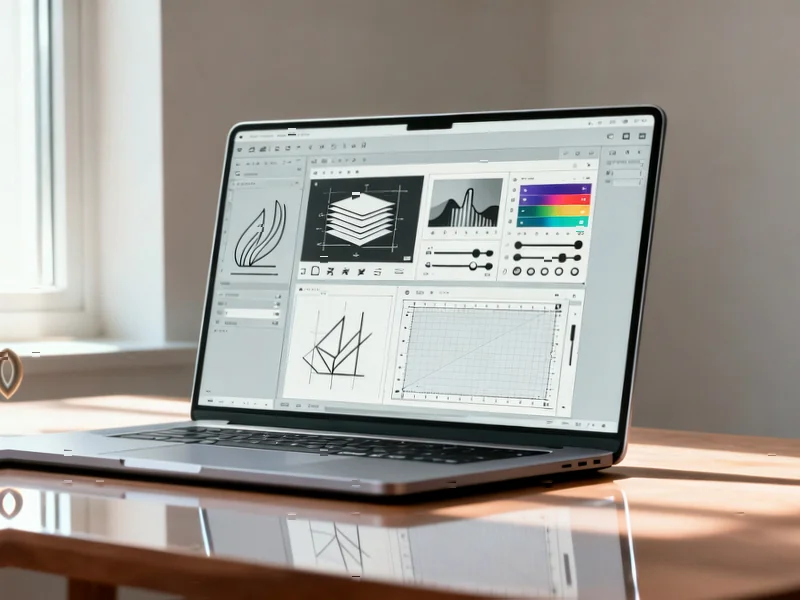According to 9to5Mac, Affinity has announced a complete overhaul of its design suite, unifying all vector, photo, and layout tools into a single free application available immediately for Mac and Windows. CEO Ash Hewson confirmed there’s “no catch, no stripped-back version” and that the same professional-grade tools will remain “completely free, forever” following the company’s acquisition by Canva last year. The new app features deep integration with Canva’s AI tools for premium subscribers, including Generative Fill and Remove Background, while maintaining that user work isn’t accessed to train AI models. The iPad version is scheduled for release next year, and all users will need a free Canva account to access the software. This dramatic shift signals a fundamental rethinking of creative software economics.
Table of Contents
- The End of the Creative Software Subscription Model?
- Canva’s Masterstroke in the Creative Tools War
- The Technical Reality Behind the “All-in-One” Promise
- Immediate Market Impact and Competitive Response
- The Privacy Question in AI-Integrated Creative Tools
- What’s Next for Creative Professionals
- Related Articles You May Find Interesting
The End of the Creative Software Subscription Model?
Affinity’s move to permanently free professional tools represents the most aggressive challenge yet to Adobe’s subscription dominance. For years, Adobe’s Creative Cloud has faced criticism for its pricing structure that locks professionals into ongoing payments. While alternatives like vector graphics tools from smaller developers have emerged, none have offered the comprehensive professional feature set that Affinity brings to the table at zero cost. This isn’t merely a freemium model with limitations—it’s the complete professional suite that previously competed directly with Adobe’s offerings. The implications for the broader creative software market could be profound, potentially forcing established players to reconsider their pricing strategies or risk losing the next generation of designers who will cut their teeth on free professional tools.
Canva’s Masterstroke in the Creative Tools War
This announcement reveals Canva’s brilliant strategic positioning following their acquisition of Affinity. Rather than maintaining Affinity as a separate premium product, they’re using it as a gateway to their ecosystem. The requirement for a Canva account, even a free one, creates an enormous funnel of professional users into their platform. For Canva Premium subscribers, the integrated AI features create a powerful value proposition that could convert casual users into paying customers. This approach mirrors successful platform strategies seen in other tech sectors, where free professional tools serve as customer acquisition vehicles for higher-margin services. The timing is particularly strategic as creative professionals increasingly seek alternatives to subscription fatigue while demanding more sophisticated AI capabilities.
The Technical Reality Behind the “All-in-One” Promise
While the unified interface promises seamless switching between vector, pixel, and layout workflows, the technical execution will be critical. Historically, software that attempts to be everything to everyone often sacrifices depth for breadth. The success of this approach will depend on whether Affinity can maintain the performance and specialized tooling that made its separate applications popular among professionals. The customizable workspace and shared studio features suggest a modular approach that could overcome the “jack of all trades” problem, but real-world performance with complex projects will be the ultimate test. Additionally, the integration of AI features directly into professional workflows represents a significant technical achievement if it can deliver the promised speed improvements without compromising creative control.
Immediate Market Impact and Competitive Response
The creative software landscape just experienced its most significant disruption in a decade. Adobe now faces unprecedented pressure to justify its subscription pricing against a free alternative that many professionals already consider superior for specific workflows. Smaller competitors like Sketch and CorelDRAW must reassess their market positioning entirely. For design education and emerging markets, this could dramatically lower barriers to entry, potentially creating a new generation of designers trained on professional-grade tools from day one. The requirement for a Canva account also positions Affinity as a strategic acquisition that could rapidly expand Canva’s user base among professional designers who previously viewed the platform as too simplistic for serious work.
The Privacy Question in AI-Integrated Creative Tools
Affinity’s explicit statement that “work is not accessed to train AI features” addresses a critical concern for professional designers working with confidential client projects. This positions them favorably against competitors who’ve faced scrutiny over training data practices. However, the integration raises questions about data flow between the applications, particularly for teams collaborating across platforms. As CEO Hewson emphasized privacy and control, the implementation details will be closely watched by enterprise users with strict compliance requirements. This could become a significant competitive advantage if executed transparently, especially for agencies handling sensitive client work.
What’s Next for Creative Professionals
The immediate availability for desktop with mobile app functionality coming next year creates an interesting phased rollout that could build momentum. For current Affinity users, the transition represents both opportunity and uncertainty—while gaining access to integrated AI features, they must adapt to a new workflow and platform dependency. The success of this bold strategy will depend on execution quality, but the mere announcement has already reshaped market expectations. If Affinity delivers on its promises without performance compromises, we may look back on this as the moment when professional creative tools became accessible to everyone, fundamentally changing how design is taught, practiced, and valued across industries.


